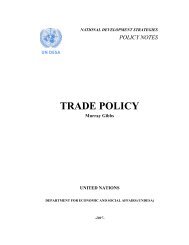Best Policy Practices
Best Policy Practices
Best Policy Practices
You also want an ePaper? Increase the reach of your titles
YUMPU automatically turns print PDFs into web optimized ePapers that Google loves.
<strong>Best</strong> <strong>Policy</strong> <strong>Practices</strong><br />
Kuyasa Low-Cost Housing<br />
City of Cape Town, South Africa<br />
The first clean development mechanism (CDM)<br />
project in Africa! In a joint energy upgrade<br />
project, national Government and the City will<br />
retrofit 2300 low income housing units.<br />
Name of the programme: Kuyasa Low-Cost Housing Project<br />
Lead institutions: The Government of South Africa and the City of Cape Town<br />
Other institutions and stakeholders involved: SouthSouthNorth (NGO)<br />
Timeframe: 2001-2005 | Status: Ongoing<br />
<strong>Policy</strong> and main objectives: South Africa has constructed<br />
much low-cost housing to meet the needs of its rural poor.<br />
Under a new policy, the Government has decided to upgrade<br />
such housing to make it more sustainable. In order to provide<br />
a new model for sustainable housing, the Cape Town City<br />
Council, in partnership with SouthSouthNorth, a non-profit<br />
development organisation, has implemented the Kuyasa Low-<br />
Cost Urban Housing Energy Upgrade Project. The project involves<br />
the retrofitting of 2300 low-income housing units. Un-<br />
der the project, a number of technological interventions were<br />
introduced in the Kuyasa housing area, including the installation<br />
of energy efficient lighting, solar water heaters, ceilings,<br />
and ceiling insulation. The result has been many sustainable<br />
development benefits.<br />
The application of suppressed demand* in the development<br />
of baselines for future housing development projects in<br />
poor parts of the world, and notably Africa, could provide necessary<br />
leverage to speed infrastructural development that involves<br />
a leap-frog to cleaner energy technologies. Kuyasa became<br />
the first clean development mechanism (CDM) project<br />
to be registered in Africa and the first Gold Standard Project<br />
in the world.<br />
Results achieved: These interventions resulted in reduced<br />
greenhouse gas emissions through the avoidance of electricity<br />
or alternative fossil fuel use by households. The project provides<br />
numerous additional sustainable development benefits<br />
such as improved health, access to energy services, and employment<br />
creation.<br />
The project was validated as a CDM project and was<br />
15
















